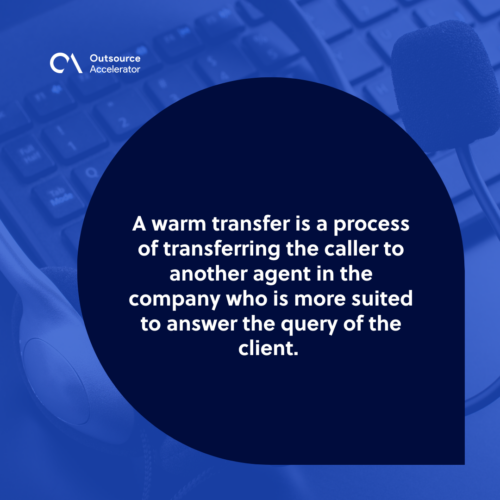Everything you need to know about warm transfers in call center

Handling customer queries and complaints is one of the manifestations of good customer relations management. However, just because concerns are addressed does not mean that the desired customer experience was achieved.
Calls need to be properly evaluated to ensure that desired standards are met. However, this is impractically impossible since call centers receive thousands of calls daily.
More importantly, some concerns need technical assistance to be addressed. Frontline agents might have limited know-how and experience to handle these calls.
This is where the concept of the warm transfer comes in handy. Experts can come into the picture to resolve the issue for the client.
But what exactly is a warm transfer? This article elaborates on how it functions and how it helps call center operations.
What is a warm transfer in a call center?
A warm transfer is a process of transferring the caller to another agent in the company who is more suited to answer the query of the client.
In this case, the receiver of the call puts the caller on hold for a few minutes so it can coordinate the details of the call with the other personnel.
This process ensures that at the receiving end of the call, either a supervisor, technical person, or someone from another department is aware of the background information before speaking to the caller.
Throughout the process, the transfer is performed without the knowledge of the caller. A ringtone is played in the background to keep the caller on hold.
Usually, a determined time is set by the agent for the transfer. The caller is notified if extensions are needed to avoid long waiting times for the callers and ensure that the agent is processing the concern.

Warm transfer vs. cold transfer
The direct opposite of warm transfer is a cold transfer, more commonly known as a blind transfer.
Under this type of transfer, the call center agent transfers the call to another party without providing the necessary information and details about the caller.
This forces the receiver of the transferred call to ask the client again for details. This is highly unpleasant for the caller since it needs to go through the same questions, and can result in annoyance.
Hence, cold transfers are not ideal for building relationships with clients as it damages the connection due to poor customer service of the call center company.
Advantages of a warm transfer
Call center companies place a huge priority on speed and efficiency. Warm transfer indeed creates a conducive customer service environment for clients. However, can agents remain efficient and fast at the same time?
A warm transfer promotes more than just efficiency. It ensures seamless operations and coordination throughout the entire organization.
Below are the main advantages of warm transfer.
Faster customer service
Warm transfer reduces the number of hold times and frustrations of clients during calls. Compared to blind transfers, which will take too much time to get into the details, warm transfer ensures swift resolution in less than 10 minutes.
Time-saving
Warm transfer reduces the average handling time of calls. Callers and agents can get right into the resolution once the call commences. This avoids redundancy and chances of follow-up calls over the same concern.
Better preparation
Agents can prepare the necessary records, documents, and software as quickly as possible, even before they talk to the transferred caller.
Faster turnaround time
Warm transfers increase the chances of first-call resolution. This means the callers do not need to wait long hours to arrive at a solution. This promotes a positive experience and better application of the human touch to customer service.

Warm transfer best practices
Here are the best practices of warm transfer.
Seek permission
Callers are sensitive when concerned about a service or product. They usually have this pent-up frustration for poor performance or glitches.
Always be polite and ask permission before holding the call, making a transfer, or doing any tests. It will mean a lot to those already irritated with the unwanted situation.
Orienting them with the step-by-step process will be helpful. This will instill understanding on their end and make them wait patiently.
Be emphatic
Knowing their concerns and the situation they have been through, be as courteous as possible. Manage their expectations well and amend for any mistakes committed.
Once the designated time is finished, inform them of any required extensions to prevent additional irritation or boredom.
Be thorough
Take all the details about the concern. Be as specific as possible with the information provided to ensure that all relevant data and information are accurate when the call is transferred to another department.
Why choose a warm transfer?
With the competition becoming fiercer, attending to client concerns in a faster and more seamless way is essential. It distinguishes companies with more compassion and cares for their bottom line from those after profit.
Customers show more loyalty to these companies, driving more growth and scalability in their operations. Warm transfers ensure that the client and customer relationship remains intact and preserved.
With the speed and accuracy of resolving concerns, customers feel valued. They are assured that there’s someone they can rely on in times of need.







 Independent
Independent




